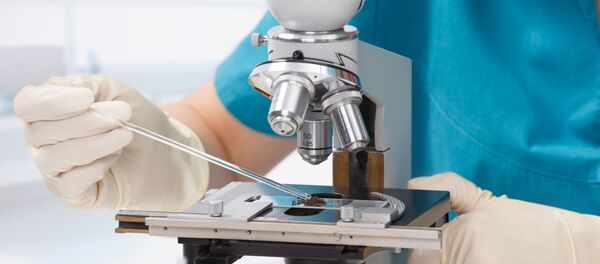An international collaboration involving Russian scientists, including researchers from NUST MISIS, are offering some new prospects for this application.
The Operational Principle and History
The ETD method can be described as follows. A charged particle passes through emulsion and activates silver bromide crystals along its path; these are converted to metallic silver nanoparticles ("grains") in the process of development.
Antoine Henri Becquerel was the first to use this method in nuclear physics in 1896, when he discovered the radioactivity of uranium salt that caused the darkening of a photographic plate.
The problem with the ETD method is that measuring nanoparticle coordinates (tracks) with an optical microscope requires a lot of labor. Measurements were performed manually for dozens of years, but fully automated microscopes made it possible to dispense with the human input. Now the ETD method could be used in DONUT and OPERA experiments and this paved the way for true breakthroughs in science.
READ MORE: Russian Physicists Upgrade Nano-Components of Flexible Electronic Devices
DONUT was launched by Fermilab in the search for tau neutrino interaction. The detector was used throughout the summer of 1997 and succeeded in discovering the tau neutrino, until then the only (with the exception of the Higgs boson) Standard Model particle inaccessible to direct observation.
In 2010, scientists obtained the first direct proof that muon neutrinos could be transformed into tau neutrinos, something that confirmed the neutrino oscillation theory.
Modern Robotised Microscopes
Multi-ton track detectors use millions of emulsion films, with automated microscopy (AM) to enable optical scanning.
Since emulsion detectors tend to reduce robot speeds, scientists are on the lookout for a method to make them faster and create next-generation robots.
Contributors from NUST MISIS and the National Institute for Nuclear Physics (INFN, Naples, Italy) wrote in a Science Reporter article that they had developed a simple and cost-effective method to speed up AM operations by up to 100 times.
"We intend to create and test a new-generation working prototype that uses our focal-plane inclination technique. Microscopes are now 100 times as fast as they used to be and thus can analyse much more data within shorter timeframes without the considerable cost", Andrey Alexandrov of NUST MISIS and INFN told RIA Novosti.
Higher microscope speeds will help scientists in many areas, including medicine, nuclear physics, astrophysics, neutrino physics, archeology, geology, volcanology, etc. Further efforts to develop a fully automated optical scanning technique and a new-generation AM will expand ETD potential and facilitate the development of detectors with tens of millions of nuclear photo-emulsion films.
READ MORE: The Aliens Are Sick! Scientists Want to Keep Eye on Space Viruses
"I think the new generation AM will use multiple cameras and the focal-plane inclination technique. We have started experimenting with laser light sources and holography to develop a next generation of superfast AM. Japan's Nagoya University has built a unique microscope, Hyper Track Selector, with 72 video cameras and a huge super-wide-angle lens. But it uses the standard scanning technique. Our technology will make it possible to reach the same scanning speed with 14 video cameras and the usual lens, which will be one order of magnitude less expensive", Alexandrov said.
The Potential for Detectors: From Dark Matter to Oncology
In the future, scientific experiments with these detectors will focus on a search for dark matter particles, neutrino physics, and ion fragmentation for the needs of hadron therapy for cancer and for protecting space crews from cosmic rays.
This is the first and so far only experiment that uses nano-emulsion films to record the paths of recoil nuclei produced by collision with dark matter particles (detectors in other similar experiments are filled with gas at low pressure).
The real challenge in this context is how to analyse dozens of tons of nano-emulsion trackers and determine the directions of tracks that are shorter than the diffraction limit of modern microscopes. This will be achieved by fast AM based on an innovative super resolution technique developed by researchers.
Some other sunrise experiments are FOOT (Fragmentation of Target) and SHiP (Search for Hidden Particles).
READ MORE: Distant Vision: US Scientists Create Lens for Eventual Artificial Eye
The FOOT experiment studies interactions between protons and carbon ions as beams pass through human tissue. Knowing ion fragmentation parameters is necessary to optimise the hadron-therapy treatment planning systems and radioprotection in space missions.
The neutrino detector of the SHiP16 (Search for Hidden Particles) experiment will use a large amount of nuclear emulsion as a tracking media to study tau neutrino physics and search for light dark matter produced in interactions of 400 GeV protons.





